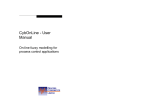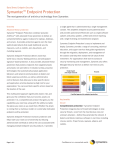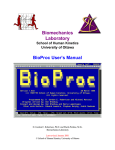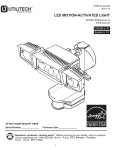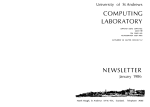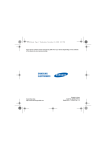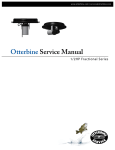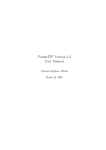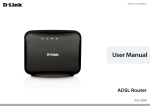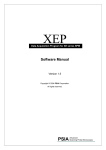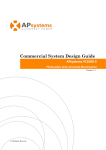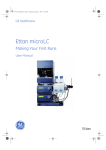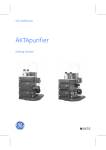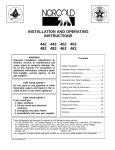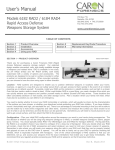Download CybMod user manual - Personal WWW Pages
Transcript
CybMod - User Manual A fuzzy modelling program for process control Table of Contents Introduction . . . . . . . . . . . . . . . . . . . . . . . . . . . 1 System Requirements ............................... 2 Installing CybMod . . . . . . . . . . . . . . . . . . . . 2 How CybMod works . . . . . . . . . . . . . . . . . . . . 3 Why fuzzy ? . . . . . . . . . . . . . . . . . . . . . . . . 3 Fuzzy Sets . . . . . . . . . . . . . . . . . . . . . . . . . 6 Fuzzy relational models . . . . . . . . . . . . . . . . . . . . . . . . . . . . . . 11 Relational model identification . . . . . . . . . 14 Dynamic Modelling . . . . . . . . . . . . . . . . . . 15 Tutorial . . . . . . . . . . . . . . . . . . . . . . . . . . . . . Loading the data . . . . . . . . . . . . . . . . . . . . Examining the data . . . . . . . . . . . . . . . . . . Naming the fields . . . . . . . . . . . . . . . . . . . Cross-correlation . . . . . . . . . . . . . . . . . . . Building the model . . . . . . . . . . . . . . . . . . Identifying the model .............................. Testing the model . . . . . . . . . . . . . . . . . . . Refining the model . . . . . . . . . . . . . . . . . . What next ? . . . . . . . . . . . . . . . . . . . . . . . 18 19 20 21 22 24 Program Reference . . . . . . . . . . . . . . . . . . . General program behaviour . . . . . . . . . . . File Menu . . . . . . . . . . . . . . . . . . . . . . . . . New System . . . . . . . . . . . . . . . . . . . . 37 37 38 39 27 29 31 35 Load a Model . . . . . . . . . . . . . . . . . . . Save a Model . . . . . . . . . . . . . . . . . . . Save a Model As . . . . . . . . . . . . . . . . . Load Data . . . . . . . . . . . . . . . . . . . . . . Save Data As . . . . . . . . . . . . . . . . . . . Exit . . . . . . . . . . . . . . . . . . . . . . . . . . . Data menu . . . . . . . . . . . . . . . . . . . . . . . . . Data file Summary ........................... Edit Field Names . . . . . . . . . . . . . . . . . Outliers Removal . . . . . . . . . . . . . . . . . Filter Data . . . . . . . . . . . . . . . . . . . . . . Cross-Correlate Data ........................... The Model Menu . . . . . . . . . . . . . . . . . . . . Model Summary . . . . . . . . . . . . . . . . . Manual Edit . . . . . . . . . . . . . . . . . . . . . Identify a sub-model ........................... Test a sub-model . . . . . . . . . . . . . . . . Save test results . . . . . . . . . . . . . . . . . Prediction Plot . . . . . . . . . . . . . . . . . . . Residuals Plot . . . . . . . . . . . . . . . . . . . The Analysis Menu . . . . . . . . . . . . . . . . . . Do a Quick prediction ........................... Model Completeness ........................... Surface plots/Stacked plot . . . . . . . . . Surface Plot/3D-Surface Plot . . . . . . . The Controller Menu .............................. The Logfiles Menu . . . . . . . . . . . . . . . . . . The Help Menu . . . . . . . . . . . . . . . . . . . . . The Main Window Dialogue . . . . . . . . . . . 39 39 39 40 40 41 41 41 43 43 45 47 50 51 52 54 57 59 59 59 62 62 63 66 67 67 68 69 70 Other Services from Process Cybernetics ................................. Other products . . . . . . . . . . . . . . . . . . . . . CybOnLine - On-line fuzzy modelling . CybFIMC - Model-based fuzzy control ........................... Services from Process Cybernetics . . . . . Training . . . . . . . . . . . . . . . . . . . . . . . . Consultancy . . . . . . . . . . . . . . . . . . . . Software services ........................... Contacting us . . . . . . . . . . . . . . . . . . . . . . 74 75 75 76 77 77 77 78 79 0 Introduction Welcome to CybMod Vs 3.0. CybMod is a powerful package for producing non-linear process models using state of the art fuzzy relational techniques. Models generated by CybMod can be easily loaded into CybOnLine and CybFIMC to provide fuzzy modelling and control functionality to your current Microsoft Windows-based SCADA system. The process of building a model starts with input/output data gathered from the system to be modelled. CybMod includes tools which let you examine this data, filter it, and remove outliers. CybMod also includes cross-correlation tools to help you generate appropriate structures for your models. Once you have chosen a model structure, building the model simply involves some pointing and clicking with the mouse. CybMod includes a variety of tools that you can then use to verify the quality of the identified model. 1 CybMod - User Manual Chapter 1 We have developed CybMod from leading edge research in fuzzy modelling and control in the process industries. Process engineers have designed the package with the process industries in mind. We are continually developing our products, and would be delighted to receive your feedback. System Requirements Pentium PC running Microsoft WIndows 95, 98, or NT. Installing CybMod Insert the diskette number 1 into the floppy disc drive. Choose the Run command from the Start menu, and in the Run window type: Chapter 2 1 How CybMod works Although it isn’t necessary to know anything about fuzzy modelling to use CybMod, some knowledge will help you get the most out of the package. Why fuzzy ? a:\setup.exe and then press enter. Follow the on-screen instructions to complete the installation. Imagine a unit in a process plant. The behaviour of the process is complex and is difficult to model using conventional mathematical approaches. Although they might not easily create a mathematical model, the operators who control the process obviously have a good understanding of it - they must already have some sort of process model in their heads. The model the operators will have of their 2 CybMod - User Manual 3 CybMod - User Manual Chapter 2 process will not be one which can be formed from differential equations, but will instead be made up of a set of rules which describe how the process will behave under different conditions (e.g. If the inlet concentration is low then the reactor temperature will fall quickly). If the operator’s model was rule-based and if they could express these rules, then, at first glance, it would appear to be simple to convert the rule-based model into a form which a computer could process (all computer languages include “ if <condition> then <action>” type statements). However, this isn’t very easy to do using conventional mathematics. To understand why, imagine we had obtained two rules which described how an operator controlled a temperature in a process: If T is HIGH then set the steam pressure LOW if T is LOW then set the steam pressure HIGH Putting these rules into a computer program is easy, provided we can explain to the computer what LOW and HIGH temperatures, and steam pressures, mean. We need to define what we mean by these terms by creating sets of LOW and HIGH temperatures and LOW and HIGH steam pressures. The definition will be highly dependant on the 4 CybMod - User Manual Chapter 2 application. A high temperature in a water bath will be much different from a high temperature in a catalytic convertor. Here, we might say that all temperatures less than 50oC were LOW, and all temperatures greater than 80oC were HIGH. For the steam pressure we might say a LOW pressure is 0.5 barg and a HIGH pressure is 5 barg. What happens if we use the rules and set definitions to control the process? When we start the process, the temperature is below 50oC, and so is classified by the computer as LOW. This means that the computer applies a HIGH steam pressure of 5 bar, and the process heats up. As the process temperature crosses the 50oC boundary, the computer has a problem - it has no rule to tell it what to do. A temperature of 51oC (or any other temperature between 50oC and 80oC) belongs to neither the HIGH nor the LOW temperature sets. If we had foreseen this problem, we might have added code to tell the computer not to change anything when the temperature doesn’t belong to either temperature set. Then, as the temperature crosses the 50oC boundary, the controller will maintain the steam pressure at the high value, and the temperature will continue to increase. As the temperature crosses the 80oC boundary, another unpleasant thing happens. At 79.9oC the 5 CybMod - User Manual Chapter 2 computer will maintain a HIGH steam pressure, but at 80oC the HIGH temperature rule will activate, and steam pressure will suddenly switch to its LOW value. The controller will then maintain the LOW value until the temperature drops to 50oC, and then the steam pressure will suddenly switch to HIGH, resulting in a temperature which oscillates between roughly 50oC and 80oC. The problem with our system is that we haven’t defined properly what a human means by the terms HIGH and LOW, or BIG or SMALL, or any of the other adjectives which are used in everyday life. Humans don’t make crisp boundaries to the sets they use to describe the world. In our process example the operator would probably regard 70oC as quite a HIGH temperature, not as HIGH as 80oC, perhaps, but still sufficient to require some attention. These leads to the idea of Fuzzy Sets. Fuzzy Sets A fuzzy set is a set where the elements can belong to the set with a variable degree of membership. By convention, this degree, or grade, of membership is a number which varies between zero and one, with zero showing that the element doesn’t belong to the set, one that it belongs completely to the set, and intermediate grades showing intermediate membership. In 6 CybMod - User Manual Chapter 2 process control problems, where we are usually dealing with continuous variables rather than discrete elements, the grade of membership of a variable to a fuzzy set is expressed as a continuous membership function. These membership functions can take many forms, but the most common, and that used in CybMod is the triangular membership function. Figure 2.1 shows a group of four typical triangular membership functions defined over a variable’s range. Three values can completely define each membership function; the variable’s value at the leftmost edge of the function where the grade-ofmembership (GM) is zero; the set centre where the GM is one; and the rightmost edge of the set where the GM is again zero. If we define a group of reference sets to be fully overlapping, then the rightmost edge of a set is at the same value as the centre point of the immediately following set, and as the leftmost edge of the set after that. Just setting the centre points of each set in the series can completely define a group of overlapping triangular reference sets. All set definitions in CybMod are fully overlapping triangular sets, because of the simplicity of definition, and because they possess very useful computational properties. 7 CybMod - User Manual Chapter 2 The two end sets of the group in fig 2.1 illustrate other features of triangular fuzzy sets. The left most set has a left value equal to its centre value, and is called a closed end set. Variable values outside a closed end set (to the left in this case) have zero membership in any of the sets. This can be useful in situations where an error needs to be flagged if a variable value falls outside a certain range. Usually, however, an open end set, such as the rightmost of the group, is much more useful. An open set has a boundary which extends to infinity which means Chapter 2 end sets in CybMod are open sets. A group of fuzzy sets defined over a variable’s range are usually called the reference sets for the variable, because they establish a frame of reference for the computer to understand rules about the system. We can give reference sets linguistic labels ((Z)ero, (S)mall, (M)edium and (L)arge in figure 2.1). This is useful when working with rule-based models, but is unnecessary and cumbersome when working with the relational models described later in the chapter. Going back to the example described earlier in the chapter, we could define a set of reference sets for the process temperature as shown in figure 2.2. Figure 2.1 - Triangular reference sets Using these fuzzy reference sets for the process temperature now produces a controller with a much more sensible control action. At temperatures below 50oC the temperature completely belongs to the LOW set and belongs to the HIGH set with a zero GM. This means that the rule associated with low temperature will fire at full strength, and the steam pressure will be set to its LOW value. As the temperature moves above 50oC, the GM in the LOW set starts to fall below one and the GM in the HIGH set starts to increase above zero. This causes the rule that all variable values on the open side of the set centre belong to the set with a GM of one. All 8 CybMod - User Manual 9 CybMod - User Manual Chapter 2 Chapter 2 this makes them a very powerful general purpose tool for process modelling and control applications. Fuzzy relational models associated with LOW temperatures to fire less strongly, and that associated with HIGH temperature to fire more strongly. After defuzzification this results in a steam pressure which gradually increases from a LOW value up to a HIGH value in the region of temperatures between 50oC and 80oC. The idea of obtaining qualitative process models from knowledgeable operators is attractive in theory, but difficult to do in practice. Operators often find it difficult to express all the knowledge they have in a coherent set of rules. When different operators are interviewed, they often come up with different, sometimes conflicting, sets of rules about the process behaviour and the best way to control it. As a result, applications of fuzzy control based around rulebased systems all have to go through a period of difficult and expensive knowledge engineering where expert interviewers obtain rule sets from operators and then, after several iterations, refine them to a complete and consistent set of rules. That is really all that there is to fuzzy modelling. In this simple example the same controller could be produced more easily with a simple linear function, but in practical systems more inputs are used, and more reference sets are used for each variable, leading to non-linear relationships between the inputs to the model and the output. Fuzzy models can represent any non-linear function, to any required degree of accuracy, and Another disadvantage with the rule-based approach for control system design is that the rules the operators give are often very conservative. A human operator is unable to devote all their attention consistently to a single control problem throughout an entire shift. This means that they make control actions which don’t move the process particularly quickly, and so give them time to focus their attention elsewhere. 10 11 Figure 2.2 - Reference sets for the temperature controller CybMod - User Manual CybMod - User Manual Chapter 2 An alternative to the rule based modelling approach is fuzzy relational modelling. The idea behind a relational model is that relationships exist, to some extent, among all the AND combinations of the inputs (e.g. HIGH flow AND MED concentration), and the output fuzzy reference sets. These relationships are fuzzy relationships, and are held in a relational array as values between zero and one (zero representing no relationship and one a very strong relationship). The modelling problem now becomes the assignment of appropriate values to the entries in the relational array. Translating rules obtained from knowledge engineering into a relational array format is possible, but it is much more common, and useful, to obtain the relational array directly from measured process input/output (i/o) data through an identification algorithm. Obtaining the model directly from process i/o data has two important advantages over the rulebased knowledge engineering approach. a) Process i/o data is easily available in most process plants. Although obtaining a good, representative, set of i/o data can be difficult sometimes, it is still much less time consuming than generating a complete and consistent rule-base. 12 CybMod - User Manual Chapter 2 b) The model which is obtained will be a representation of the process i/o relationships present in the identification supplied. It will not represent the operator’s opinion of, and prejudices about, the process behaviour. Including such a model in a model-based control scheme will allow much tighter control than that which could be achieved from the knowledge engineering approach. Although a relational model doesn’t usually incorporate human operators knowledge directly, it does use the same qualitative structure that humans use to deal with real world complexity. This provides computer based systems with a very powerful way of dealing with complex process behaviour. Relational model identification There are a wide range of different ways of identifying fuzzy relational models. The method used in CybMod, direct-least squares, is one of the best and is described below. It isn’t necessary to know how this identification algorithm works to use CybMod, and the details are included for information only. A fuzzy relational model is usually represented 13 CybMod - User Manual Chapter 2 by Y'R X1 X2 ÿ Xn where Y Xi R " = = = = Possibility vector of the output Possibility vector of the ith input Fuzzy relational array Fuzzy compositional operator A Possibility Vector is a vector made up of the grades of membership of a particular variable value in each of the reference sets used to describe that variable. The fuzzy compositional operator is the method used to combine the inputs and relationships to form a prediction; there are several different ways of doing this. If a particular form of fuzzy composition is used (summated-product), and a property of fully overlapping reference sets invoked, then the relational model equation can be expressed as Chapter 2 This form of the relational equation is linear in the parameters (R’), and can be identified using normal linear least-squares techniques. CybMod uses a recursive least-squares identification algorithm which allows multiple i/o data sets to be easily processed. Dynamic Modelling Most models used directly for control are dynamic, that is they model not only how big changes are, but also how quickly they take place. A fuzzy relational model is not inherently dynamic, but is simply a static mapping between combinations of inputs and the corresponding output. However a relational model can be formed to represent a discrete-time(sampled) dynamic system. Consider the following first-order dynamic process dy 'f ( y, u1, ÿ ,u n) dt y'R ). kron (X1 , X2 , ÿ , Xn) where y = R’ = kron() = 14 Scalar (non-fuzzy) value of the output Reordered fuzzy relational array Kronecker tensor product (just an ordered multiplication) of the input possibility vectors CybMod - User Manual where y = ui = f = process output ith process input some function a backward difference discrete time 15 CybMod - User Manual Chapter 2 approximation of this process can be formed as: y(k)&y(k&1) 'f ( y(k&1) , u1(k&1),ÿ, u n(k&1)) ∆t where k = ∆t = current sample number sampling interval Chapter 2 process deadtime. This deadtime will either be real and/or will be included to approximate higher-order process dynamics ( as a first-order + dead-time model). A typical fuzzy relational dynamic model for a process will therefore look like this: Y(k)'R Y (k&1) U1 (k&1&τ1) ÿ Un (k&1&τn) and, after rearrangement y (k)'f ) (y(k&1) , u1(k&1), ÿ , u n(k&1)) where f’ is a modified form of the function f. where Y Ui k τi = = = = possibility vector of the output possibility vector of process input i current sample dead-time on input i This can easily be expressed as a fuzzy relational model: Y(k)'R Y(k&1) U1(k&1) ÿ Un(k&1) Higher-order dynamic models can be created simply by adding additional lagged outputs (and, perhaps, inputs) on the right-hand side of the relational equation. In practical situations it usually isn’t a good idea to go beyond first-order model dynamics because of the problems in obtaining complete and representative data. In most practical situations additional lags will be introduced into the input variables to represent 16 CybMod - User Manual 17 CybMod - User Manual Chapter 3 Chapter 3 Loading the data Start CybMod by selecting CybMOd from the Windows start menu. 2 From CybMod's File menu, select the Load Data item. This will bring up a standard Windows file dialogue. Select the file 'boxjen.dat' from the c:\CybMod directory. CybMod's Window display will change to show the model building dialogue. Tutorial The best way to learn how to do something is to do it. This chapter introduces you to the use of the CybMod program by going through the stages involved in building a model of a simple dynamic process. You should read the manual alongside your computer and follow the exercise through. A set of sample data (boxjen.dat) is included with CybMod, and can be found in the c:\CybMod directory. This data is the famous Box-Jenkins laboratory furnace data and consists of three fields of data: the sample number; the fuel flowrate deviation; and the off-gas concentration. The object is to build a dynamic model of the offgas concentration. 18 CybMod - User Manual 19 CybMod - User Manual Chapter 3 Chapter 3 giving you a chance to look at how the data is distributed. Examining the data Before we start to build a model we need to look at the data that we have just loaded. From the Data menu, select the Data file summary item. A window will appear which gives a summary of the information contained in the data file. Have a look at the data fields. Field_0 is just the sample number, and will produce a rather strange looking histogram! Field_1 is the fuel flowrate deviation, and the histogram shows an approximately Gaussian distribution. Field_2 is the off-gas concentration, and the histogram shows a distribution which is slightly skewed towards higher gas concentrations. Naming the fields It's easy to get confused when referring to the fields of data as 'Field_0', 'Field_1', etc, and so it's worthwhile giving them meaningful names early in the model building process. From the Data menu, select the Edit Field Names item. From the summary we can see that the data file consists of 296 samples of data, each containing three data fields. Information about the individual data fields can be obtained by selecting the field name from the Field Information list box. The Histogram button plots a histogram of the data, The list box in this dialogue gives you access to all the field 20 21 CybMod - User Manual CybMod - User Manual Chapter 3 Chapter 3 names stored internally by CybMod. To change a name simply select a field from the list box and then edit it using the keyboard. To edit another, just repeat the process. Change 'Field_0' to 'Sample No', 'Field_1' to 'Fuel', and 'Field_2' to 'Conc'. Press OK to tell CybMod to save the changes. Cross-correlation Cross-correlation is a statistical technique which is sometimes useful in detecting dynamic relationships between variables. It works by calculating the correlation coefficient between two variables at a range of different lags. To run a cross-correlation analysis, select Cross-Correlate Data from the Data menu. Two list boxes are displayed on the dialogue box which appears: 'Input variable'; and 'Output variable'. Select 'Fuel' as the input variable, and 'Conc' as the output variable, and then press the XCorr button to carry out the cross-correlation. After a few seconds a graph will appear on the right of the dialogue. This graph shows the results of the cross-correlation analysis. The x22 CybMod - User Manual axis is the relative lag between the input and the output. The y-axis is the correlation coefficient. High absolute values of the correlation coefficient at positive lags indicate a causal relationship between the input and the output, and high values at negative lags indicate a causal relationship between the output and the input (due to feedback in the process). In this example, a high negative correlation occurs at a lag of five samples ( to zoom in on the graph, left-click and drag select the area you want magnify, and right-click to restore the graph). This gives us an idea of the lag that we might want to apply to the input in the dynamic model we shall be building. 23 CybMod - User Manual Chapter 3 Chapter 3 Cross-correlation suffers from a number of limitations. In cases where an output is affected by several inputs, and these inputs change in a non-random manner, the cross-correlation results can be impossible to interpret. Also, with high-order processes, the best lag on the input can be over-estimated. Building the model If you haven't already done so, close the crosscorrelation dialogue. On the main Window you'll see a list box which lets you select the output for your new model. From this list box select 'Conc'. Below this is another list box which allows you to select the default number of reference sets to be applied to each input in the new model. For now just leave this at '2'. For this example, however, we want to build a dynamic model, so leave the lagged output as it is. The current model structure is shown as a fuzzy relational equation. By default, a lagged value of the output is used as a model input creating the basis of a first-order dynamic model. If you want to create a steady-state model, just double-click the lagged output and change it to the input you want (remember to set the lag to zero). At the bottom of the display the centre points of the reference sets for the model variables are listed. These sets are automatically created by spacing them equally between the minimum and maximum values present in the data set for the variable in question. Usually, you should at least change the end set positions to the minimum and maximum values you would ever expect to see in the 'real world'. To change the set positions double-click on the reference set centre points. This brings up a set editing dialogue. To change the position of a particular centre point, double- 24 25 To create the model press the Create button. A new card will be created containing your initial model structure. CybMod - User Manual CybMod - User Manual Chapter 3 click on the value in the reference set centres Chapter 3 at '2', and press the OK button. A new input (Fuel(k-5)) will be added to the model structure display. Change the values of the reference set centres for this variable to '-3' and '3'. Identifying the model Now that we have set the model structure we need to identify the relational array entries. To do this select the Identify a sub-model item from the Model menu. Make sure that the 'Model 1' tab is selected on the main window display (all the modelling menus refer to the currently selected sub-model). frame, and then edit the value in the edit box that pops up. For this example, change the two set centres to 40 and 65. Click the Done button to close the 'Edit reference sets' dialogue. We are now ready to add another input to the model. Click the Add a new Input button on the main window dialogue. Select 'Fuel' from the list box in the dialogue that appears. Set the lag value to '5' (the value obtained from crosscorrelation), leave the number of reference sets 26 CybMod - User Manual CybMod provides two ways of presenting the data to the identification algorithm. The first is sequentially where the data is presented in sequence from the first sample to be used to the last. The second is randomly, where a fraction of the total number of examples are chosen at random from the data (the same example can be chosen several time, so that 75% on the dialogue doesn't mean that three-quarters of the data will be used). 27 CybMod - User Manual Chapter 3 If you intend to use all the data for identification, or you want to identify only on a fixed portion of the data, then sequential presentation is best. If you intend to use only part of the data for identification, but the whole set for testing, then random presentation is best since samples will be chosen across the whole range of data. This is useful if the data covers several different Chapter 3 example, choose random presentation by selecting the Use data drawn randomly option. The % of data to be used is the number of presentations of data to the identification algorithm expressed as a percentage of the total number of samples in the data (e.g. if a file consists of 500 samples, a value of 150% will present 750 examples to the identification algorithm). The random number seed is used to initialise the random number generator. Leave both as they are, and press the OK button to start the identification process. A progress bar will appear, and, after a few seconds, the dialogue will disappear - identification is now complete. Testing the model To test the model, select the Test a sub-model item from the Model menu. The dialogue allows you to set the range of samples to be included in the test. The Steps ahead list allows you to specify how far ahead you want the model to predict. SIngle-step ahead ing es. For 28 operat regim this CybMod - User Manual 29 CybMod - User Manual Chapter 3 Chapter 3 Refining the model Model building is an iterative process where different models are built, compared against each other and refined. CybMod includes several tools to help you with this process. prediction, where the current value of the real output is used, isn't too much of a challenge. Multi-step ahead prediction, where predictions are based on one or more previous predictions is a much better way of assessing model quality. The most difficult test is the 'free running' predictor where the model is only supplied with the initial value of the output, and all subsequent predictions are based on previous model outputs. Select 'Free' from the list to run the model as a free running predictor. Press the Test button. After a few seconds summary results of the test will appear at the bottom of the dialogue. Note that the mean squared error is 2.04, the maximum error is 4.57, and the AIC (Akaike Information Criterion, a measure of accuracy vs. complexity) is 0.742. Press the Cancel button to close the test dialogue. 30 CybMod - User Manual One useful thing to do is to look at the model residuals (the differences between the predicted and actual outputs). CybMod lets you plot the residuals against all the data fields (Model|Residuals plot), and also lets you crosscorrelate the residuals (Model|XCorr Residuals) against the data fields. For now, cross-correlate the residuals against the 'Fuel' ( the dialogue works just like data crosscorrelation, except that only the input needs to be set). Your results should look like this : Notic that 31 e we CybMod - User Manual Chapter 3 are getting a strong correlation of the residuals with the 'Fuel' at a lag of 4 samples. This lag was not used in the original model, and could be worth evaluating more carefully. Close the cross-correlation dialogue by pressing the Done button. On the main window dialogue for model 1, double-click on the 'Fuel(k-5)' term in the model structure display. This will bring up an edit dialogue. Chapter 3 in model performance (also reflected in the AIC dropping to -0.027). The maximum error, however, hasn't been reduced by much; it still has a value of 3.83. Have a look at the prediction plot (Model|Prediction plot). You should see that the model tracks the real process output closely for most of the range, but loses accuracy in the last thirty or so samples - it looks as though the process has changed in some way in this region, and more experimental investigation would be needed to find out what was happening. The model we are using at the moment has only two reference sets defined for each variable, and as a result is almost linear. Highly non-linear processes need more reference sets defined on one or more of the inputs (depending where the non-linearity is). Look at the residuals plot for the fuel input Change the lag on the 'Fuel' variable from 5 to 4, and press the OK button to complete the edit. Identify the model again using random presentation and the default identification parameters. Run a model test with a free running predictor. You should find that the mean squared error has dropped to 0.948 indicating a significant increase 32 CybMod - User Manual 33 CybMod - User Manual Chapter 3 The largest values of the residuals seem to be clustered close to the '0' value, which could indicate the presence of a non-linearity in this region. We need to add some more reference sets to the 'Fuel' variable in this region to check this. Close the residuals plot and double-click the 'Fuel(k-4)' field in the model structure on the main window dialogue. In the variable edit dialogue which appears, change the number of reference sets to '4'. Press the OK button to make the edit and note that the reference sets defined on this variable have increased in number. Double-click the reference set definitions for the 'Fuel' variable in the Reference Sets frame to bring up the set centre editing dialogue. Change the values of the sets centres to (-3, -0.1, 0.1, 3.0) and exit the editing dialogue. Now identify the model again (still using random presentation and default parameters). Test the model as a free running predictor. The value of the mean squared error should have dropped to 0.874. Although it looks as though we now have a better model, we have to be careful. The number of entries in the relational array have increased from four (2 x 2) to eight (2 x 4), and so that it is not surprising that the model error has reduced. The 34 CybMod - User Manual Chapter 3 AIC which balances model performance against model complexity has also reduced indicating that the change we have made could be worthwhile. If you look at the residuals plot for the fuel, however, you'll find that the largest are still clustered near zero, and so we haven't solved that problem. The largest residuals actually come from the end of the data set, where, from earlier, we think that the process has changed in some way. The fuel flowrate in this region coincidently has values close to zero, and it is this and not non-linearity which is producing the cluster of residuals near zero 'fuel' values. It is probably best in this case to use only two reference sets on each variable. This coincides with other investigations which have been carried out on this data set, and which have concluded that the process is nearly linear in the range which the data covers. What next ? Process modelling is an art. Although CybMod provides a useful range of tools, it will take experience to know when it is best to use them, and how best to interpret the information which comes from them. 35 CybMod - User Manual Chapter 3 A good understanding of the process to modelled is very important for effective modelling. Use your own process data and practise building models. Are the models sensible? Are the lags reasonable? Does the prediction surface slope in the right direction? The more you use CybMod, the better you'll get ! Chapter 4 3 Program Reference This chapter describes the functions available in CybMod in detail. We recommend that you get familiar with the program using the tutorial first, and then use this chapter to fill in you knowledge. General program behaviour The information you will see in CybMod displays is colour coded according to what you can do with it: Yellow background - information only Blue background - 36 CybMod - User Manual 37 can be double clicked to bring up additional CybMod - User Manual Chapter 4 Chapter 4 dialogues White background - data can be typed in directly from the keyboard Most of the 2-D graphic displays can be zoomed to look at data in finer detail. To zoom in, left-click and drag-select the area of interest and then release the mouse button. Click the right mouse button to reset the display back to the original size. New System Selecting this menu item will clear CybMod of all currently loaded model and data, and reset the program for a new problem. If you haven’t saved your model, or modified data, you’ll be given the option to do so. Load a Model Loads a previously saved model. If the number of data fields used to develop the loading model is different from the number of fields in any currently loaded data, then loading will be stopped and an error announced. File Menu Save a Model Saves the currently loaded model - all submodels will be saved, along with tagname definitions, model summary information, and the model log. The model is saved with the default extension ‘*.pcg’, and the log file with the extension ‘*.mlg’. Save a Model As Allows you to save previously loaded model 38 CybMod - User Manual 39 CybMod - User Manual Chapter 4 under a different name. Chapter 4 CybMod either by filtering it, or by removing outliers. Load Data Exit Loads a process i/o data file. Doing this when CybMod is empty will cause the main window to change to the model creation dialogue. If a model, or another datafile, is currently loaded then CybMod will check that the field count is consistent with the new data, if it isn’t then loading will be aborted and an error will be flagged. Loading new data will erase the previous data set. Data files for CybMod have to be standard ASCII text. The data is arranged with the fields in comma, space, or tab delimited columns, and the records (samples) in rows. Non-numeric information in a data file will cause an error on loading. Exits the program, prompting you to save any modified models and/or data. Data menu The data menu provides you with some tools to exam, modify, and process i/o data files. Save Data As Data file Summary Allows you to save the datafile under a different name, and also saves the data log. The data is saved with the default extension ‘*.dat’, and the log file with the extension ‘*.dlg’. This is only useful if you modify the data within 40 CybMod - User Manual Shows a dialogue containing summary information about the currently loaded data. The dialogue lists the model file name, the number of samples of data, and the number of fields in each sample. 41 CybMod - User Manual Chapter 4 Chapter 4 Edit Field Names The lower part of the dialogue, enclosed in the frame, allows more detailed information to be obtained about each field within the data. If you select a data field in the list box, then CybMod will calculate the maximum, minimum and mean values of the data, and its standard deviation. Clicking the ‘Histogram’ button will generate a histogram showing the distribution of the values of the data in the currently selected field. When a new data file is loaded the fields are automatically named ‘Field_0', ‘Field_1', etc. It is much less confusing if the data fields are given meaningful names, and this dialogue allows you to do this. Simply select the field you would like to rename from the list of available fields, and type the new name in the edit box. Continue to select and edit as many names as you require, and press ‘OK’ to finish. The ‘Cancel’ button will close the dialogue without saving the edited field names. Outliers Removal Sometimes process data will contain values which are unreasonably large or small. The most common reason for these outliers are ‘spikes’ from analytical instruments, with gas analysers 42 CybMod - User Manual 43 CybMod - User Manual Chapter 4 being particularly prone to this problem. These Chapter 4 acceptable data values to anything you wish by editing the boxes in the frame in the lefthand side of the dialogue. Pressing the ‘Try it’ button plots the new limits on the graph, highlights the outliers with red crosses, and provides a count of the outliers at the bottom of the dialogue. At this stage the data is unchanged. Pressing the ‘Apply It’ button will apply CybMod’s outlier removal. CybMod does this by simply replacing outliers with a value interpolated from the nearest valid data. Once this is done, the data set loaded in CybMod has been changed irrevocably - if you want to return to the old data, then you must reload it. values need to be removed prior to model identification to prevent them from skewing the results. The outliers removal dialogue provides access to CybMod’s routine for removing outliers. Select the field to be processed from the ‘Datafield’ list. A plot of the data will appear on the graph on the right-hand side of the dialogue. Two dotted green lines also appear on the plot showing the maximum and minimum acceptable values of the data. This is initially set to 5% outside of the maximum and minimum values in the data set. You can change the maximum and minimum 44 CybMod - User Manual Outlier removal should be used with caution. It is necessary to remove genuinely spurious data, but removal of data because it ‘doesn’t look right’ can lead to seriously flawed models. Most data will not require outlier removal. Filter Data Process i/o data gathered for model identification should ideally already be properly filtered using analogue and digital filters. In some cases, however, particularly in initial modelling investigations, only unfiltered or poorly filtered data is available. CybMod includes a simple firstorder filtering algorithm to deal with this. 45 CybMod - User Manual Chapter 4 Chapter 4 The ‘Do it’ button actually applies the filter to the data field. The only way to restore the original data will be to reload it into CybMod. The ‘Done’ button simply closes the dialogue. Filtering is something that has to be done with caution. Applying a filter can remove noise, but it removes some useful data too. Also you need to remember that if you have applied a filter to build a model in CybMod you must make sure that the same filter is applied to SCADA data prior to it being passed to CybOnLine or CybFIMC loaded with that model. The filter parameters are specified through the filter dialogue. The data field to be filtered is first selected from the list box. This will trigger the production of a graph of the data in the right-hand side of the dialogue. The two edit boxes on the left of the dialogue allows the sample time at which the data was gathered to be set, and a filter time constant to be specified. The ‘Try it’ button lets you try the filter on the data without actually changing the data stored in CybMod. The graph will show the effect of the filter parameters you have chosen. Increasing the value of the filter time constant will increase the amount of filtering which takes place. 46 CybMod - User Manual Cross-Correlate Data Cross-correlation is a tool to help in spotting relationships in dynamic data. It essentially involves calculating the correlation coefficient between an input and an output data series with different values of lag between the data. Cross-correlation can be carried out in CybMod through the Cross-Correlation dialogue. The input and output data are selected from the list boxes (it is possible to select the same data for each and carry out an auto-correlation). The maximum lag over which the correlation will be evaluated can be adjusted by changing the number in the ‘maximum lag’ box. 47 CybMod - User Manual Chapter 4 Sometimes false correlations can be detected when both the input and output are subjected to Chapter 4 The x-axis of the graph shows the relative lag of the input to the output. Positive values of lag represent causal relationships between the input and the output. Negative values represent causal relationships between the output and the input (feedback relationships). The y-axis of the graph shows the value of the correlation coefficient. Positive values indicate a positive gain between the input and output, and negative values a negative gain. Two yellow and two green dotted lines run horizontally across the graph. These are the 95% (yellow) and 99% (green) confidence limits on the correlation coefficient based on a t-test. an external influence which cause both to move. To prevent this from happening a de-trending filter is applied to both sets of data. The order of this filter can be adjusted by editing the ‘Filter Order’ box. The filter order shouldn’t be changed unless you have a good reason for doing it. Pressing the ‘XCorr’ button will carry out the cross-correlation calculation. This will take a few seconds, and the time required will increase with the size of the data set, the maximum lag, and the filter order. When the calculation is complete the results will be displayed in the graph on right of the dialogue. 48 CybMod - User Manual The solid line on the graph represents the results of the cross-correlation. The strongest peak (positive or negative) on the positive side of the xaxis can give a reasonable first estimate for the ‘dead-time’ between the input and the output. Cross-correlation works best for processes which are dominated by one big capacity (a single big time constant). In these cases a clear peak will be observed and this can be used with some confidence to form a model structure. When process involved multiple capacities with similar time constants, then the results are less useful. The best that can be hoped for in these cases is a rough idea of the most appropriate lag that can be 49 CybMod - User Manual Chapter 4 refined by trial and error during model building. Cross-correlation results can also be difficult to interpret when an output is subject to several nonrandom inputs. The Model Menu The model menu is only activat ed when a submodel is selected from the main window model building dialogue. Most of the functions on the model menu (apart from the Model Summary) act only on the currently selected sub-model. 50 CybMod - User Manual Chapter 4 Model Summary The model summary simply provides information about the model you are working on. The summary applies to, and is the same for, all the sub-models. You can enter a suitable system name - the system name is used by CybOnLine as the topic name for DDE conversations with the SCADA package. If you intend to run multiple on-line modellers, then you need to make sure that the models they use are allocated different system names. 51 CybMod - User Manual Chapter 4 The ‘General Remarks’ is just text that is saved along with the model. You can use it to add reminders to yourself about the model. Manual Edit Chapter 4 The manual editing dialogue works by taking twodimensional slices through the relational array. The variables to be used for the x and y axes are selected from the two list boxes, and the ‘slice’ appears in the big box on the righthand side of the dialogue. The values highlighted with a yellow background along the top of the box are the centre points of the reference sets for the ‘xvariable’. The yellow highlighted values down the lefthand edge are the reference set centres for the ‘y-variable’. The values in the edit boxes in the centre of the box are the relational array entries, and can be changed simply by typing in a new value. In cases where the model has more than two inputs, there will be more than one possible 2-D slice. To access the individual slices a list box appears at the bottom of the display when three or more inputs are present. Clicking on an input in this list brings up a popup menu showing the set centres for that variable. Clicking on one of these brings up the appropriate 2-D slice. Manual editing allows you to go right into the relational array and change the values stored there. Since changing relational array entries is likely to have wide ranging effects, it is something that should only be attempted with extreme care. It is, however, sometimes useful in situations where data is missing or suspect. 52 CybMod - User Manual Once again manual editing in not something to undertake lightly. There are usually better ways of dealing with model or data problems. 53 CybMod - User Manual Chapter 4 Chapter 4 set for identification (perhaps to keep the rest for testing). The maximum number of samples available for identification will be less than the number of samples in the data if lags are present in the model structure. Identify a sub-model The identification parameters allows you to control the identification algorithm. If the ‘Clear Model First’ box is checked then the existing model will be erased prior to the identification. If you are identifying a model from multiple data sets then you would need to make sure that this box is unchecked on processing the second and subsequent data sets. The ‘Forgetting Factor’ value allows the forgetting factor on the recursive least-squares algorithm to be adjusted. If this is moved to a value less than one then more recent information will be given more weight in the identification process. This is only useful if you believe that the process is non-stationary. Unless you have a very good reason to change it then leave it at one ! There are two versions of this dialogue. The first, shown above, is used when the ‘Use data sequentially’ option is selected. In this case identification is carried out by moving through the data from the start sample sequentially to the end sample. The start sample and the end sample can be adjusted if you wish to use only part of the data 54 CybMod - User Manual Pressing ‘OK’ will start the identification process. This can take quite a long time with big data sets, lots of model inputs and lots of reference sets - if you are finding it too long, then the process can be stopped by pressing the ‘Cancel’ button. The other form of the identification dialogue appears when the ‘Use data drawn randomly’ option is selected. 55 CybMod - User Manual Chapter 4 Chapter 4 The dialogue allows the percentage of data to be used for identification and the random number seed to be specified. Choosing the same random number seed will always result in the same sequence of data being drawn from the data set. Test a sub-model W hen this op tion is chosen identification will be carried out with a portion of the data drawn at random from the whole set of data. This is useful where only part of the data is to be used for identification, but where the data is non-uniform with one operating state at the start of the data and another at the end. Building a model sequentially would result in a very good model of the data at the start, and no model at all of the end condition. 56 CybMod - User Manual This dialogue allows a prediction test to be run on a sub-model using the currently loaded data set. The range of data to be used for the test can be set by editing the start and end sample values. 57 CybMod - User Manual Chapter 4 The ‘Steps ahead’ list controls the way the prediction is carried out. Remember that a dynamic fuzzy model is generally of the form y(k)'f (y(k&1) % some inputs) if the current value of y (y(k)) is predicted using the value of y(k-1) from the i/o data (single-step prediction), then good prediction results are really easy to acheive. In fact a pretty good single-step predictor is just y(k)'y(k&1) Although this gives good single-step prediction results, it is pretty useless for control and on-line modelling purposes. This means that single-step prediction performance is not a particularly good measure of a model. Multi-step prediction, where the model has to predict several steps ahead, using its previous predictions as a base for the next, is a much better test. The most stringent test is a freerunning prediction where the model is only told the first value of the output, and has to generate the rest of its predictions based on its own previous outputs. The ‘Test’ button starts a test and the ‘Cancel’ button closes the dialogue. When a test is complete a frame will appear at the bottom of the 58 CybMod - User Manual Chapter 4 dialogue giving summary test statistics. Save test results Selecting this menu item after a model test will bring up a dialogue allowing you to specify a filename and location for saving the test results. The results are saved with the original data occupying the first fields, and the model prediction placed in the last field. Where lags are present in model, the first predictions can't be made and are instead replaced with the actual value of the output. Prediction Plot This produces a graph comparing the predicted and actual outputs from the process. The menu item isn’t available until a test has been run on the current sub-model. Residuals Plot Generates a plot of the model residuals (the difference between the predicted and actual outputs), against either the sample number or each of the data fields. Simply select the variable you want to plot the 59 CybMod - User Manual Chapter 4 Chapter 4 XCorr Residuals residuals against from the list. By examining the residuals plot you can get an indication that your model is missing some important variables. The residuals should be evenly distributed on either side of the x-axis - if they are not you may have a problem. The residuals plot has to be used with caution in dynamic systems since there may be a lag in the effect of variables on the output. It is useful, however, for giving a quick check on the suitability of a sub-model. 60 CybMod - User Manual This dialogue allows you to cross-correlate the model residuals against each of the fields of data. A high value of the correlation coefficient indicates a significant contribution to the model error. If it occurs for fields or lags that are not currently included in the sub-model, then it probably means that the model’s prediction performance could be improved by including the data field as an input. Remember that a high correlation does not necessarily imply that adding that variable will reduce the prediction error by a worthwhile amount. 61 CybMod - User Manual Chapter 4 Chapter 4 can be used to obtain predicted output values for any desired set of inputs. It’s useful for checking particular points on the sub-models prediction surface. The Analysis Menu Th e analysis me nu provides you with some tool s to analyse the characteristics of the model rather than just its predictive performance. To carry out a quick prediction you first need to specify the values of the inputs. Select an input from the ‘Variable Name’ list and you will see its currently stored value appear in the edit box to the right. By default all inputs are set to their lowest values. You can edit the stored value of the input by typing directly into the box. Once you’ve set up your input list, press the ‘Go’ button and the model prediction will appear. Press ‘Done’ to exit the dialogue. Do a Quick prediction Model Completeness One of the problems in modelling non-linear systems is obtaining a set of identification i/o data which completely covers the required operating range. CybMod includes a mechanism for keeping track of what data has been seen in a frequency or ‘F-array’. This 62 dialogue CybMod - User Manual The F-array stores the sum of the values of the input tensor products associated with particular combination of inputs. The value stored in the Farray is therefore a measure of how often, and how strongly, a particular combination of inputs 63 CybMod - User Manual Chapter 4 Chapter 4 dialogue a number of summary statistics are presenent giving the maximum, minimum and mean values of the entries in the F-array. Underneath the statistics is an edit box which allows you to set a minimum level for the value of F (when the form is loaded this is set at zero, and the test has already been performed). Pressing the ‘Test’ button scans the F-array and counts the values which are less than or equal to your minimum acceptable level. The count is given as a percentage completeness (70% means the model is 70% complete, i.e. 30% of the entries are equal to or below the minimum level). The box below lists the indices of the F-array entries which have failed the test. For example an entry in the box of ‘(1,3)’ means that the input combination of (input 1, set 1) and (input2, set 3) has a frequency value lower than your acceptable level. has been seen by the identification algorithm. A zero value in the F-array means that the input combination has never been seen, and that the model shouldn’t be used to predict in this region. A low value means that the input combination has been seen only weakly and infrequently, and that model performance in this region may be unreliable. The completeness dialogue provides you with a way to examine the F-array. At the top of the 64 CybMod - User Manual There are a variety of ways of dealing with an incomplete model. The most obvious is to gather more data in the incomplete regions, but this is often difficult as there are usually practical reasons for the data being missing in the first place. Another way is to alter the set definitions. By shifting set boundaries, or eliminating sets altogether most incompleteness problems can be solved (but perhaps at the cost of overal model performance). The last method is to go into the 65 CybMod - User Manual Chapter 4 model and manaully edit the suspect entries. This is a last resort ! Chapter 4 Surface Plot/3D-Surface Plot The 3-D surface plot presents similar information to the stacked plot and works in the same way. Surface plots/Stacked plot The stacked surface plot presents the sub-models prediction surface on a 2-D plot. Two input variables have to be selected from the list boxes at the top of the diaologue. The model prediction is calculated for the full-range of the ‘x-axis’ variable, and at set centre points for the ‘stacked’ variable. When more than two inputs are present an extra list at the bottom of the dialogue allows the stored values for the other inputs to be specified (set centre points only). 66 CybMod - User Manual The 3-D surface can be rotated by clicking and dragging on the plot with the left mouse button. The Controller Menu The controller menu is used to specify modelbased fuzzy controllers for CybFIMC, and is described in that programs documention. 67 CybMod - User Manual Chapter 4 Chapter 4 entries to the log file by typing into the edit box and pressing the ‘Add entry’ button. The Logfiles Menu Log files are saved whenever the model or data files is saved. A model log has a file extension of ‘*.mlg’, and a data log has an extension of ‘*.dlg’. Model logs are saved as ASCII file and are for your information only - they do not affect the operation of CybMod. The Help Menu Provides access to CybMod help. Context sensitve help is also available by pressing the ‘F1' function key. Tooltips are also available on many controls. Simply leave the mouse cursor over a dialogue item you are unsure about and a tooltip should appear. Logfiles are created for both models and data. The logfiles are automatically updated when something significant happens. You can add your 68 CybMod - User Manual 69 CybMod - User Manual Chapter 4 Chapter 4 variable and default number of reference sets from the lists, and then press the ‘Create’ button. The Main Window Dialogue The main window dialogue is where the construction of a models structure takes place, and is presented as a series of cards. A model is a collection of up to nine individual sub-models and each has their own card on the dialogue. You can use the sub-models to create and save different input structures for modelling the same input, or you can use them to collect a group of different output models which are based on the same data set. A new card will be created for the sub-model. The frame at the top of the card shows the current sub-model structure as a fuzzy relational equation. A lagged value of the output is automatically inserted as an input, but if you want to create a steady-state model (perhaps for an on-line estimator for use in CybOnLine), then simply double-click the lagged input and change it to the desired input. The first card on the dialogue allows you to create a new submodel. Simply select the desired output To add another input to the model, click the ‘Add a new input’ button. This will bring up a dialogue allowing you to select the input from the list of 70 CybMod - User Manual 71 CybMod - User Manual Chapter 4 Chapter 4 data fields, the lag to be applied to the input, and the number of reference sets to be used to describe the input. The check-box at the bottom indicates whether the variable is usable as a manipulation in a model for CybFIMC. Checking an unchecked box will simply re-order the model to make the variable the last model input (see CybFIMC documentation for more details). A similar dialogue appears if one of the existing inputs are double-clicked, allowing them to be edited. To change the reference set postions double-click the appropriate reference set group in the set frame. This will bring up a dialogue which lists the individual set centres, and also gives a graphical representation of the sets. To change a set centre position, then double-click the appropriate entry and edit the value in the dialogue box In the frame at the bottom of the main window dialogue is a list of the reference set centre points for the currently defined inputs. The reference set values are initialised by linearly spacing them from the minimum to the maximum value of the appropriate input. 72 CybMod - User Manual 73 CybMod - User Manual Chapter 5 Chapter 5 Other products CybOnLine - On-line fuzzy modelling 4 Other Services from Process Cybernetics We hope that you find CybMod a useful and easy to use piece of software. All our software is written in-house and we are continually developing our products. We are very interested in receiving your feedback on our products. If you have any comments to make, or suggestions for improvements to our products, then please get in touch with us at the address given at the end of this chapter. CybOnLine provides an easy way of intergrating models developed in CybMod with a wide range of third-party SCADA systems. These models could be used for inferring the values of difficult to measure variables from other measurements, or could be used to provide 'what-if' support for process operators. CybOnLine is a Dynamic Data Exchange (DDE) server. It runs, as a seperate task, alongside your existing DDE-capable SCADA system and communicates via DDE links. These links are easy to set up, usually just by setting an appropriate i/o address. Each CybOnline module can handle up to nine sub-models (the maximum which can be defined in CybMod), and multiple copies of CybOnLine can be run simultaneously providing as many online models as you require. The rest of this chapter outlines some of the other products and services available from Process Cybernetics. 74 CybMod - User Manual 75 CybMod - User Manual Chapter 5 CybFIMC - Model-based fuzzy control CybFIMC adds fuzzy model-based control capability to your existing Windows based SCADA system. It takes a model, generated in CybMod, and incorporates it into a Fuzzy Internal Model Control (FIMC) scheme. This provides full non-linear feedback control with dead-time compensation, and feedforward action on any included disturbances. CybFIMC, like CybOnLine is a DDE server making it really easy to link to exisiting SCADA installations. CybFIMC is a MISO (Multi-input/Single-output) controller; it controls a single output variable which can be subjected to several inputs. Multiples copies of CybFIMC can be run simultaneously providing as many loops as you require. Chapter 5 Services from Process Cybernetics Training Process Cybernetics offers ocassional courses on various aspects of fuzzy modelling and control. The courses include a mixture of both theory and practise. If you would like to be kept informed of upcomming courses then tick the boxes on your registration card, or contact us directly at the address given at the end of this chapter. Consultancy Process Cybernetics can provide consultancy to help support your modelling and control projects. The level of our consultancy involvement can range from telephone support to full project management. We shall provide a fixed-price quotation for any work we undertake. If you are interested in our consultancy services, then contact us at the address given at the end of the chapter. 76 CybMod - User Manual 77 CybMod - User Manual Chapter 5 Chapter 5 Software services All our software is written in-house, and, as a result, we are able to offer a 'bespoke tailoring' service to make our software suit your particular requirements. This could involve changing the look of the software, changing the way it operates, or integrating it with other applications. If you have an application in mind that requires special software, then contact us at the address at the end of the chapter. We will discuss your requirements and provide you with a fixed price quotation for the work. Contacting us Process Cybernetics no longer exists as a company, but you can still contact: Dr. Bruce Postlethwaite Dept. of Chemical and Process Engineering University of Strathclyde, James Weir Building 75 Montrose St. Glasgow Scotland, UK Tel: 0141 548 2835 Email: [email protected] 78 CybMod - User Manual 79 CybMod - User Manual










































